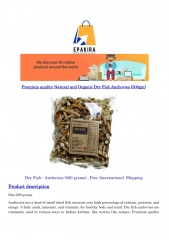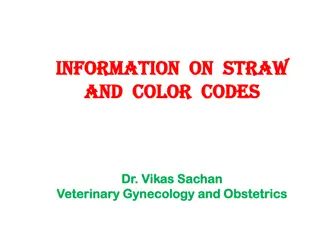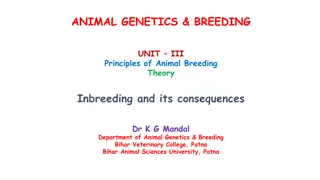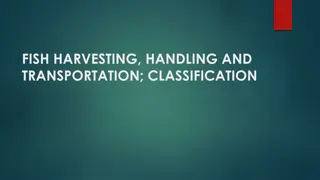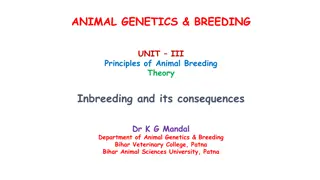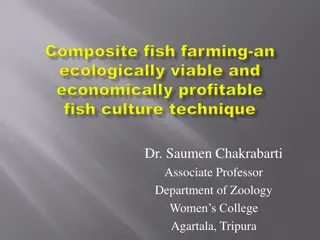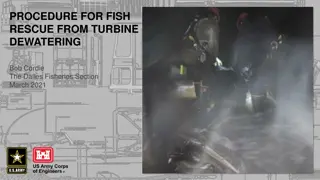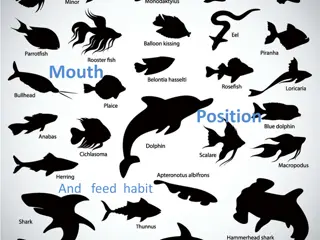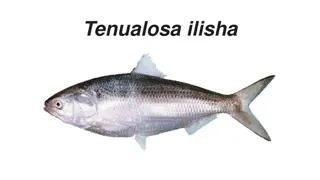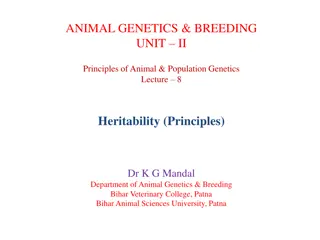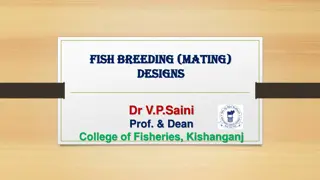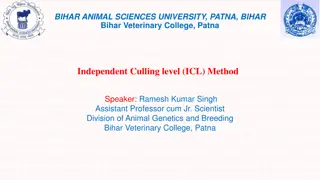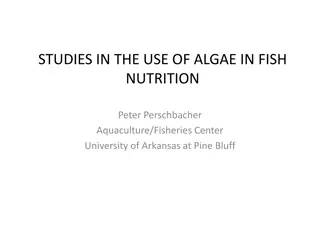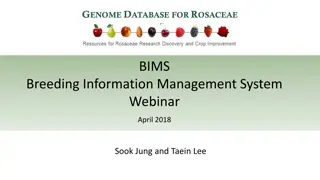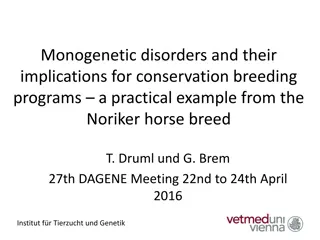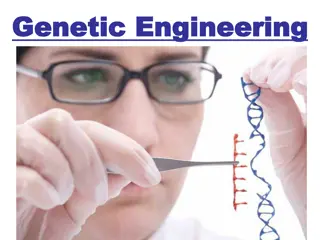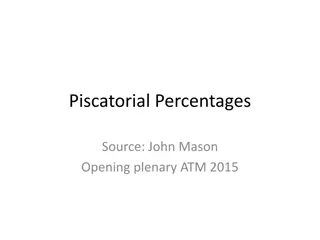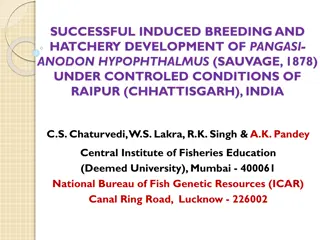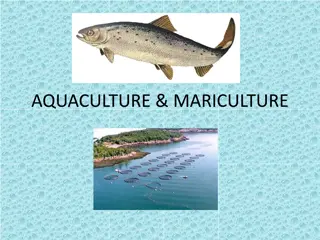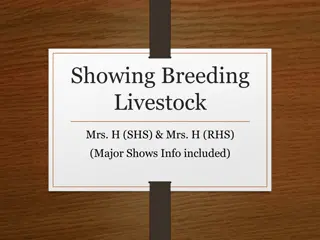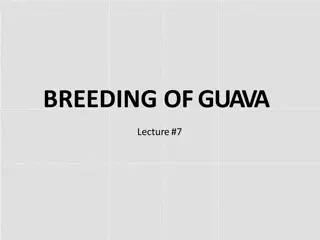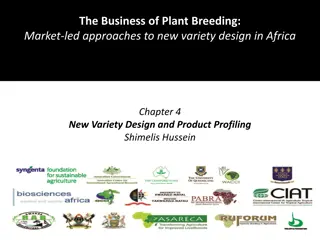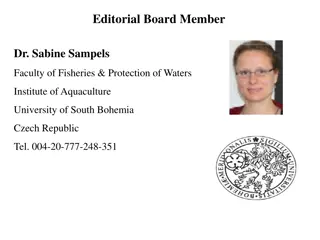Premium quality Natural and Organic Dry Fish Anchovies (500gm)
Dry Fish - Anchovies (500 grams) , free shipping worldwide\n\nProduct description\n\nSize:500 grams\n\nAnchovies are a kind of small dried fish contains very high percentage of calcium, proteins, and omega -3-fatty acids, minerals, and vitamins, for healthy body and mind. Dry fish anchovies are comm
0 views • 3 slides
Guide to Efficient Rodent Breeding and Colony Management
This comprehensive guide covers essential aspects of rodent breeding, colony management, and tips for successful rodent reproduction. It includes details on weaning, retiring breeders, records management, problem-solving, resources, goals and planning, breeding systems, reproduction processes, genot
4 views • 35 slides
Understanding Fish Ecology: Interactions, Diversity, and Environmental Factors
Fish ecology involves studying the distribution, interactions, and abundance of fish species in different ecosystems. This lab delves into the divisions of ecology, fish species diversity in marine and freshwater ecosystems, and the environmental factors affecting fish diversity and abundance. Disco
1 views • 7 slides
Understanding Breeding Soundness and Straw Identification in Cattle
Learn about the importance of evaluating breeding soundness in bulls, maintaining insemination records, and identifying straws for successful reproduction in cattle. Dr. Vikas Sachan provides valuable insights on bull identity, semen station codes, production dates, and color codes for different bre
1 views • 7 slides
Different Methods of Genetic Modification in Plants
Genetic modification in plants can occur through natural selection, selective breeding, and induced mutations. Natural selection involves breeding compatible species to create offspring with desired traits, while selective breeding is a multi-generational process to breed organisms with specific cha
0 views • 11 slides
Understanding Inbreeding and Its Consequences in Animal Genetics & Breeding
Inbreeding in animal breeding involves mating closely related individuals, resulting in common ancestors within the preceding generations. This practice can have both positive and negative consequences on genetic diversity and health. Various types of inbreeding such as selfing, full-sib mating, and
0 views • 18 slides
Principles of Animal Breeding: Introduction and Historical Perspective
This unit covers the introduction to animal breeding, the application of genetics principles in breeding, historical perspectives including the work of Robert Bakewell, and key events in animal breeding evolution. Topics include breeding systems, importance of animal breeding, and notable figures in
1 views • 12 slides
All About Fish and Shellfish: Types and Characteristics
Explore the world of seafood with a detailed overview of fin fish, shellfish, and their various sub-categories. Learn about the characteristics of white fish, including flat and round varieties, as well as oily fish. Discover the differences between fin fish and shellfish, such as crustaceans and mo
1 views • 18 slides
Fish Processing and Preservation Methods for Quality and Longevity
Fish are highly perishable and require proper preservation techniques to maintain their quality and freshness. Methods such as chilling, freezing, and other preservation techniques are employed to extend the shelf life of fish for short and long durations. Quick freezing is preferred for long-term s
1 views • 17 slides
Overview of Fish Harvesting, Handling, and Transportation
Fish harvesting is crucial for providing valuable animal protein, with India being a key player in fish production. Fisheries are categorized into fin and non-fin types, with capture and culture fisheries being common practices. Capture fisheries involve natural species recruitment in sea and inland
2 views • 16 slides
Fish Breeding and Spawn Management Techniques by Dr. S.P. Sahu
Dr. S.P. Sahu, an Assistant Professor at Bihar Veterinary College in Patna, provides valuable insights into fish breeding and spawn management. The content covers fish seed collection, procurement methods, fry identification, and confined water breeding techniques. Detailed information on Indian maj
2 views • 26 slides
Understanding Inbreeding in Animal Genetics & Breeding
Explore the principles of animal breeding theory focusing on inbreeding and its consequences, including examples like selfing, full-sib mating, and genetic effects. Learn about close breeding, line breeding, and genetic consequences of inbreeding in animal populations. Discover how inbreeding affect
0 views • 13 slides
Livestock Breeding Policy for Genetic Improvement of Cattle and Buffalo in India
India's diverse agro-ecological regions host a wide range of farm animal breeds. The livestock breeding policy aims to enhance the productivity of cattle and buffalo through strategies such as grading up with indigenous superior dairy breeds, crossbreeding with high-yielding exotic breeds, and selec
1 views • 23 slides
Composite Fish Farming: An Innovative Aquaculture Technique
Composite fish farming is a popular aquaculture technique where different compatible fish species are cultured together in ponds to maximize fish production. Researchers from India and abroad have contributed significantly to this field. The practice involves combining Indian major carps like Catla,
1 views • 19 slides
Principles and Systems of Poultry Breeding: A Comprehensive Guide
Poultry breeding, led by experts like Dr. Suchit Kumar, involves purposeful selection and mating to improve size, weight, egg production, and meat quality. Environmental factors are crucial, and different breeding systems like inbreeding and line breeding play a role in genetic improvement. Continuo
1 views • 21 slides
Guide to Fish Rescue from Turbine Dewatering Process
Detailed procedure for rescuing fish from turbine dewatering, including steps like hoisting sturgeon, salvaging fish in tanks, and using gantry cranes to transport them. The process involves specialized equipment and careful handling to ensure the safety of the fish. Images illustrate key steps in t
2 views • 9 slides
Understanding Average Gene Effect and Breeding Value in Animal Genetics
In the field of animal genetics and breeding, it is crucial to comprehend the average effect of genes and breeding value of individuals. Genes are transmitted from parents to offspring through haploid gametes, influencing the genotype and breeding potential. Estimating the average effect of a gene i
4 views • 26 slides
Principles of Animal Breeding Theory and Methods of Selection
Animal breeding involves selecting for desirable traits to improve the overall merit of animals. Methods such as tandem selection and multi-trait selection are used to enhance genetic progress. Economic value, genetic significance, and selection criteria play important roles in the breeding process.
1 views • 16 slides
Understanding Fish Mouth Positions and Feeding Habits
The position of a fish's mouth reveals valuable information about its feeding habits, behavior, and lifestyle. Fish mouths can be categorized as superior (upward-facing), terminal (forward-facing), or inferior (downward-facing), each adapted for specific feeding strategies. Superior mouths are ideal
5 views • 10 slides
All You Need to Know About Hilsa Fish
Hilsa herring, also known as Hilsa shad, is a sought-after food fish in the Indian Subcontinent, particularly in Bangladesh, India, and West Bengal. This marine species belongs to the herring family, Clupeidae, and can grow up to 60cm in length. It is an anadromous fish, schooling in coastal waters
0 views • 5 slides
Understanding Heritability in Animal Genetics and Breeding
Heritability is a crucial concept in animal genetics and breeding, indicating the proportion of total phenotypic variance attributed to genetic effects. It helps in predicting breeding values, assessing relationships between individuals, and guiding genetic determinations. Properties of heritability
2 views • 20 slides
Fish Breeding Mating Strategies and Designs for Effective Population Management
Designing mating strategies to maximize the effective breeding population in fish hatcheries is crucial for maintaining genetic diversity and overall fitness. Random mating, simple paired mating, factorial mating, and other breeding designs are discussed to help hatchery managers improve breeding co
4 views • 13 slides
Independent Culling Level (ICL) Method in Animal Breeding
The Independent Culling Level (ICL) method involves selecting multiple traits simultaneously in animal breeding. Breeders set minimum or maximum culling levels for each trait, ensuring continuous improvement in desired characteristics through successive generations. However, challenges exist in dete
0 views • 6 slides
Studies in the Use of Algae in Fish Nutrition by Dr. Peter Perschbacher
Dr. Peter Perschbacher, an Associate Professor at the University of Arkansas, specializes in exploring the benefits of algae in fish nutrition. His research interests include polycultures, algae as fish meal replacements, alligator gar ecology, and more. He has received numerous honors and awards fo
0 views • 28 slides
Efficient Breeding Management System for Individual Breeders
Explore how the Breeding Information Management System (BIMS) empowers breeders to store, manage, and analyze breeding program data efficiently. With features like data integration, statistical analysis, and mobile app utilization, BIMS revolutionizes the way breeders make informed breeding decision
0 views • 45 slides
Monogenetic Disorders in Noriker Horses: Implications for Conservation Breeding Programs
This study explores monogenetic disorders, specifically PSSM Type1, in Noriker horses, highlighting the impact of GYS1 gene mutation on breeding practices. The research delves into carrier frequencies across diverse horse breeds and emphasizes the importance of genetic screening in conservation bree
1 views • 18 slides
Understanding Genetic Engineering and Selective Breeding
Genetic engineering involves changing the DNA in living organisms to create new traits, resulting in genetically modified organisms (GMOs). Techniques include artificial selection, cloning, gene splicing, and gel electrophoresis. Selective breeding is a form of artificial selection where animals wit
4 views • 37 slides
Managing Fish Barriers in Scotland: Improving Water Environments
The management plans and implementation of fish barriers measures in Scotland aim to address key pressures on the water environment, such as fish migration, physical condition, and pollution. The initiative involves categorizing barriers, taking actions on fish migration, scoping barriers, assessing
0 views • 9 slides
Solving the Piscatorial Percentages Problem
The "Piscatorial Percentages" problem involves a fish tank with 200 fish, 98% of which are small. By removing a certain number of small fish, the goal is to leave 96% of the total fish as small fish. Two approaches are discussed to reach the solution, resulting in the removal of 100 small fish in bo
0 views • 25 slides
Understanding Aquatic Epidemiology in Fish Populations
Aquatic epidemiology is a crucial branch of science that focuses on describing the health, diseases, and welfare of fish populations. It involves studying diseases in wild and hatchery-raised fish, identifying factors influencing disease occurrence, and conducting diagnostic investigations to mainta
0 views • 12 slides
Challenges and Solutions in Fish Truck Fleet Logistics
Addressing the complexities of managing a large and aging fish truck fleet, the challenges include maintaining safety, operational costs, fleet efficiency, and replacement timing. Solutions involve collaboration with hatchery managers, experts' advice on fleet replacement, and working with agencies
0 views • 11 slides
Successful Induced Breeding and Hatchery Development of Pangasianodon Hypophthalmus under Controlled Conditions
Pangasianodon hypophthalmus, also known as striped catfish, has gained popularity in aquaculture markets. This species, native to Southeast Asia, has shown promising potential for freshwater catfish culture, with high demand for its white fillets in various countries. The article discusses successfu
0 views • 22 slides
Understanding Aquaculture and Mariculture Practices
Aquaculture encompasses the breeding, rearing, and harvesting of aquatic organisms in various water environments, while mariculture focuses on marine plants and animals in marine or brackish water. This includes controlled breeding for commercial, recreational, and conservation purposes. Technologic
0 views • 30 slides
Livestock Showing and Breeding Guidelines for Students
This guide provides information on showing and breeding livestock for students, including details on the animals involved, purchasing options, requirements, eligibility, show dates, and quality counts. Students can learn about breeding animals, preparing for shows, and following guidelines set by th
0 views • 25 slides
Guava Breeding: Strategies and Objectives for Improved Cultivation
Guava, a hardy fruit grown in various states in India, has significant breeding objectives such as developing seedless varieties, enhancing pectin content, achieving uniform ripening, and improving resistance to pests. Various genotypes and floral biology aspects play a role in the breeding process.
0 views • 38 slides
Market-Led Approaches to New Variety Design in Africa
Explore Chapter 4 of "The Business of Plant Breeding" focusing on new variety design and product profiling in Africa. Understand core methods of product profiling, trait prioritization, and setting breeding objectives to meet client needs. Learn how to create new designs, set benchmarks, and make tr
0 views • 45 slides
Understanding Selective Breeding: Benefits and Process
Selective breeding is a method where humans control the breeding of organisms to emphasize or eliminate specific traits. By choosing parents with desirable characteristics, breeders aim to create offspring with those traits. While advantageous for creating economically important varieties, it can al
0 views • 12 slides
Genomic Recursions in Genomic BLUP for Animal Breeding
Explore the application of genomic recursions in single-step genomic best linear unbiased predictor (BLUP) for genetic evaluations in animal breeding. Understand the significance of using genomic data to improve genetic selection, increase accuracy, shorten generation intervals, and enhance genetic
0 views • 31 slides
National Programme for Bovine Breeding and Dairy Development Overview
The National Programme for Bovine Breeding and Dairy Development (NPBBDD) is a Government of India funded project aimed at enhancing bovine breeding and dairy development in the country. It consists of two components: National Plan for Bovine Breeding (NPBB) and National Plan for Dairy Development (
0 views • 30 slides
Dr. Sabine Sampels: Research on Aquaculture, Fish Quality, and Human Health
Dr. Sabine Sampels, a member of the Editorial Board at the University of South Bohemia, Czech Republic, specializes in studying the effects of fish consumption on human health, animal nutrition on fish quality, and lipid metabolism. With a background in Food Chemistry and extensive research experien
0 views • 25 slides
